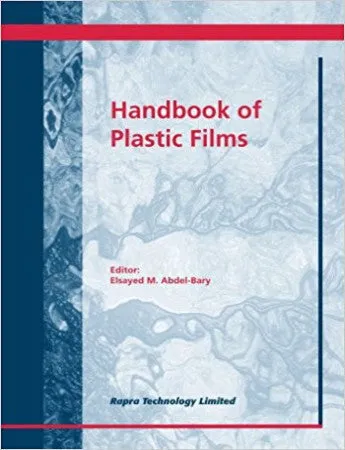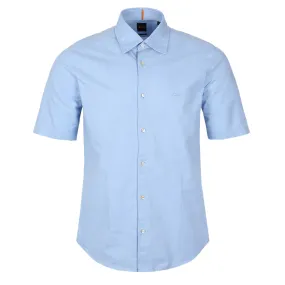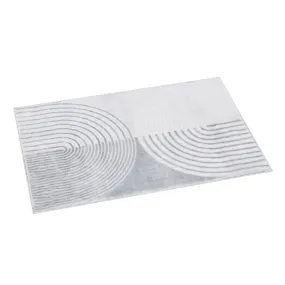Description
Author: Prof. E. Abdel-BaryISBN 978-1-85957-338-9
pages 404
Summary
Plastic films are high-performance materials which play an essential part in modern life. Plastic films are mostly used in packaging applications but as will be seen from this book they are also used in the agricultural, medical and engineering fields. The plastics films industry uses state-of-the-art manufacturing processes and is continuously seeking out new technologies to improve its performance.The understanding of the nature of plastic films, their production techniques, applications and their characterisation is essential for producing new types of plastic films. This handbook has been written to discuss the production and main uses of plastic films.
Chapter 1: Technology of Polyolefin Film Production, deals with the various types of polyolefins and their suitability for film manufacture.
Chapter 2: Processing of Polyethylene Films, the main parameters influencing resin basic properties are described.
Chapter 3: Processing Conditions and Durability of Polypropylene Films, details the structure, synthesis and film processing of polypropylene.
Chapter 4: Solubility of Additives in Polymers, deals with different aspects of additives solubility in polymers in relation to the polymer degradation and stabilisation.
Chapter 5: Polyvinyl Chloride: Degradation and Stabilisation, covers the stability of polyvinyl chloride (PVC) films during procesing and service.
Chapter 6: Ecological Issues of Polymer Flame Retardancy, discusses flame retardants, which as special additives have an important role in saving lives. These flame retardant system basically inhibit or even suppress the combustion process by chemical or physical action in the gas or condensed phase.
Chapter 7: Interaction of Polymers with Nitrogen Oxides in Polluted Atmospheres, covers thermal and photochemical oxidation of polymers under the influence of the aggressive, polluting atmospheric gases.
Chapter 8: Modifications of Plastic Films, discusses the modifications of plastic films required to improve their mechanical or physical properties to meet the requirements of certain applications.
Chapter 9: Applications of Plastic Films in Packaging, deals with applications of plastic films in packaging.
Chapter 10: Applications of Plastic Films in Agriculture, deals with the application of plastic films in agriculture.
Chapter 11: Physicochemical Criteria for Estimating the Efficiency of Burn Dressings, deals with the principal medical treatment of burns using dressings made with a polymeric layer or layers.
Chapter 12: Testing of Plastic Films, covers the most common test methods generally used for plastic films. The requirements necessary for the test methods are summarised.
Chapter 13: Recycling of Plastic Waste, covers the problem of plastic films recycling Different types of recycling are discussed and recycling of some selected types of films are discussed. This book will be invaluable to anyone who is already working with plastic films or to anyone who is considering working with them in the future.
Table of Contents
1. Technology of Polyolefin Film Production1.1 Introduction
1.2 Structures of the Polyolefins
1.2.1 Low-Density Polyethylene (LDPE
1.2.2 High-Density Polyethylene (HDPE,MDPE,UHMWPE
1.2.3 Linear Low-Density Polyethylene (LLDPE
1.2.4 Very-and Ultra-Low-Density Polyethylene (VLDPE,ULDPE
1.2.5 Polypropylene (PP
1.2.6 Polypropylene Copolymers
1.3 Morphology of Polyolefin Films
1.4 Rheological Characterisation of the Polyolefins
1.4.1 High-Density Polyethylene
1.4.2 Linear Low-Density Polyethylene
1.4.3 Very-and Ultra-Low-Density Polyethylene
1.4.4 Low-Density Polyethylene,Long Branches
1.4.5 Polypropylene
1.5 Blown Film Production (Tubular Extrusion
1.5.1 Extruder Characteristics
1.5.2 Screw Design
1.5.3 Frost-line and Blow Ratio
1.6 Cast Film Production
1.6.1 Extrusion Conditions
1.6.2 Calendering Finishing
1.6.3 Extrusion Coating
1.7 Orientation of the Film
1.7.1 Orientation During Blowing
1.7.2 Orientation by Drawing
1.7.3 Biaxial Orientation (Biaxially Oriented PP,BOPP)
1.8 Surface Properties
1.8.1 Gloss
1.8.2 Haze
1.8.3 Surface Energy
1.8.4 Slip
1.8.5 Blocking
1.9 Surface Modification
1.9.1 Corona Discharge
1.9.2 Antiblocking
1.9.3 Slip Additives
1.9.4 Lubricants
1.9.5 Antistatic Agents
1.10 Internal Additives
1.10.1 Antioxidants
1.10.2 Ultraviolet Absorbers
1.11 Mechanical Properties
1.11.1 Tensile Properties
1.11.2 Impact Properties
1.11.3 Dynamic Mechanical Properties
1.11.4 Dielectric Properties
1.12 Microscopic Examination
1.12.1 Optical – Polarised Light Effect with Strain
1.12.2 Scanning Electron Microscopy (SEM)– Etching
1.12.3 Atomic Force Microscopy (AFM)
1.13 Thermal Analysis
1.13.1 Differential Scanning Calorimetry (DSC)
1.13.2 Temperature-Modulated DSC (TMDSC)
1.14 Infrared Spectroscopy
1.14.1 Characterisation
1.14.2 Composition Analysis of Blends and Laminates
1.14.3 Surface Analysis
1.14.4 Other Properties
1.15 Applications
1.15.1 Packaging
1.15.2 Laminated Films
1.15.3 Coextruded Films
1.15.4 Heat Sealing
1.15.5 Agriculture
1.16 Conclusion
2. Processing of Polyethylene Films
2.1 Introduction
2.2 Parameters Influencing Resin Basic Properties
2.2.1 Molecular Weight (Molar Mass)and Dispersity Index
2.2.2 Melt Index (Flow Properties
2.2.3 Density
2.2.4 Chain Branching
2.2.5 Intrinsic Viscosity
2.2.6 Melting Point and Heat of Fusion
2.2.7 Melt Properties – Rheology
2.2.8 Elongational Viscosity
2.2.9 Elasticity
2.3 Blown Film Extrusion (Tubular Film
2.3.1 Introduction
2.3.2 Description of the Blown Film Process
2.3.3 Various Ways of Cooling the Film
2.3.4 Extruder Size
2.3.5 Horsepower
2.3.6 Selection of Extrusion Equipment
2.4 Cast Film Extrusion
2.4.1 Description of the Cast Film Process
2.4.2 Effects of Extrusion Variables on Film Characteristics
2.4.3 Effect of Blow-up Ratio on Film Properties
2.5 Processing Troubleshooting Guidelines
2.6 Shrink Film
2.6.1 Shrink Film Types
2.6.2 Shrink Film Properties
2.6.3 The Manufacture of Shrink Film
2.6.4 Shrink Tunnels and Ovens
3. Processing Conditions and Durability of Polypropylene Films
3.1 Introduction
3.2 Structures and Synthesis
3.3 Film Processing
3.4 Additives
3.5 Ultraviolet Degradation of Polypropylene
3.5.1 UV Degradation Mechanisms
3.5.2 Effect of UV Degradation on Molecular Structure and Properties of PP
3.5.3 Stabilisation of PP by Additives
3.6 Case Studies
3.6.1 Materials and Experimental Procedures
3.6.2 Durability-Microstructure Relationship
3.6.3 Durability-Processing Condition Relationship
3.6.4 Durability-Additive Property Relationship
3.7 Concluding Remarks
4. Solubility of Additives in Polymers
4.1 Introduction
4.2 Nonuniform Polymer Structure
4.3 Additive Sorption
4.4 Quantitative Data on Additive Solubility in Polymers
4.5 Factors Affecting Additive Solubility
4.5.1 Crystallinity and Supermolecular Structure
4.5.2 Effect of Polymer Orientation
4.5.3 Role of Polymer Polar Groups
4.5.4 Effect of the Second Compound
4.5.5 Features of Dissolution of High Molecular Weight Additives
4.5.6 Effect of Polymer Oxidation
4.6 Solubility of Additives and Their Loss
5. Polyvinyl Chloride:Degradation and Stabilisation
5.1 Introduction
5.2 Some Factors Affecting the Low Stability of PVC
5.3 Identification of Carbonylallyl Groups
5.4 Principal Ways to Stabilise PVC
5.5 Light Stabilisation of PVC
5.6 Effect of Plasticisers on PVC Degradation in Solution
5.7 ‘Echo ’ Stabilisation of PVC
5.8 Tasks for the Future
6. Ecological Issues of Polymer Flame Retardants
6.1 Introduction
6.2 Mechanisms of Action
6.3 Halogenated Diphenyl Ethers – Dioxins
6.4 Flame Retardant Systems
6.5 Intumescent Additives
6.6 Polymer Organic Char-Former
6.7 Polymer Nanocomposites
7. Interaction of Polymers with the Nitrogen Oxides in Polluted Atmospheres
7.1 Introduction
7.2 Interaction of Nitrogen Dioxide with Polymers
7.2.1 Vinyl Polymers:PE,PP,PS,PMMA,PAN,PVC and PVF
7.2.2 Non-Saturated Polymers
7.2.3 Polyamides,Polyurethanes,Polyamidoimides
7.3 Reaction of Nitric Oxide with Polymers
7.4 Conclusion
8. Modifications of Plastic Films
8.1 Introduction
8.2 Modification of Mechanical Properties
8.2.1 Orientation
8.2.2 Crystallisation
8.2.3 Crosslinking
8.3 Chemical Modifications
8.3.1 Fluorination
8.3.2 Chlorination
8.3.3 Bromination
8.3.4 Sulfonation
8.3.5 Chemical Etching
8.3.6 Grafting
8.4 Physical Methods Used for Surface Modification
8.4.1 Plasma Treatment
8.4.2 Corona Treatment
8.5 Characterisation
8.5.1 Gravimetric Method
8.5.2 Thermal Analyses
8.5.3 Scanning Electron Microscopy
8.5.4 Swelling Measurements
8.5.5 Molecular Weight and Molecular Weight Distribution
8.5.6 Dielectric Relaxation
8.5.7 Surface Properties
8.5.8 Spectroscopic Analysis
8.5.9 Electron Spectroscopy for Chemical Analysis (ESCA) or X-Ray Photoelectron Spectroscopy (XPS)
8.6 Applications
9.Applications of Plastic Films in Packaging
9.1 Introduction
9.2 Packaging Functions
9.3 Flexible Package Forms
9.3.1 Wraps
9.3.2 Bags,Sacks and Pouches
9.3.3 Pouch Production
9.3.4 Dispensing and Reclosure Features
9.4 Heat-Sealing
9.5 Other Uses of Packaging Films
9.6 Major Packaging Films
9.6.1 Low-Density Polyethylene (LDPE)and Linear Low-Density Polyethylene (LLDPE)
9.6.2 High-Density Polyethylene (HDPE)
9.6.3 Polypropylene (PP)
9.6.4 Polyvinyl Chloride (PVC)
9.6.5 Polyethylene Terephthalate (PET)
9.6.6 Polyvinylidene Chloride (PVDC)
9.6.7 Polychlorotrifluoroethylene (PCTFE)
9.6.8 Polyvinyl Alcohol (PVOH)
9.6.9 Ethylene-Vinyl Alcohol (EVOH)
9.6.10 Polyamide (Nylon)
9.6.11 Ethylene-Vinyl Acetate (EVA)and Acid Copolymer Films
9.6.12 Ionomers
9.6.13 Other Plastics
9.7 Multilayer Plastic Films
9.7.1 Coating
9.7.2 Lamination
9.7.3 Coextrusion
9.7.4 Metallisation
9.7.5 Silicon Oxide Coating
9.7.6 Other Inorganic Barrier Coatings
9.8 Surface Treatment
9.9 Static Discharge
9.10 Printing
9.11 Barriers and Permeation
9.12 Environmental Issues
10. Applications of Plastic Films in Agriculture
10.1 Introduction
10.2 Production of Plastic Films
10.3 Characteristics of Plastic Films Used in Agriculture
10.4 Stability of Greenhouse Films to Solar Irradiation
10.4.1 Ultraviolet Stabilisers
10.4.2 Requirements for Stabiliser Efficiency
10.4.3 Evaluation of Laboratory and Outdoor Photooxidation
10.5 Other Factors Affecting the Stability of Greenhouse Films
10.5.1 Temperature
10.5.2 Humidity
10.5.3 Wind
10.5.4 Fog Formation
10.5.5 Environmental Pollution
10.5.6 Effects of Pesticides
10.6 Ageing Resistance of Greenhouse Films
10.6.1 Measurement of Ageing Factors
10.6.2 Changes in Chemical Structure
10.7 Recycling of Plastic Films in Agriculture
10.7.1 Introduction
10.7.2 Contamination by the Environment
11. Physicochemical Criteria for Estimating the Efficiency of Burn Dressings
11.1 Introduction
11.2 Modern Surgical Burn Dressings
11.2.1 Dressings Based on Materials of Animal Origin
11.2.2 Dressings Based on Synthetic Materials
11.2.3 Dressings Based on Materials of Vegetable Origin
11.3 Selection of the Properties of Tested Burn Dressings
11.3.1 Sorption-Diffusion Properties
11.3.2 Adhesive Properties
11.3.3 Mechanical Properties
11.4 Methods of Investigation of Physicochemical Properties of Burn Dressings
11.4.1 Determination of Material Porosity
11.4.2 Determination of Size and Number of Pores
11.4.3 Estimation of Surface Energy at Material-Medium Interface
11.4.4 Determination of Sorptional Ability of Materials
11.4.5 Determination of Air Penetrability of Burn Dressings
11.4.6 Determination of Adhesion of Burn Dressings
11.4.7 Determination of Vapour Penetrability of Burn Dressings
11.5 Results and Discussion
11.5.1 Determination of Sorption Ability of Burn Dressings
11.5.2 Kinetics of the Sorption of Liquid Media by Burn Dressings
11.5.3 Determination of Vapour Penetrability of Burn Dressings
11.5.4 Determination of the Air Penetrability of Burn Dressings
11.5.5 Determination of Adhesion of Burn Dressings
11.6 The Model of Action of a Burn Dressing
11.6.1 Evaporation of Water from the Dressing Surface
11.6.2 Sorption of Fluid by Burn Dressing from Bulk Containing a Definite Amount of Fluid
11.6.3 Mass Transfer of Water from Wound to Surroundings
11.7 Criteria for the Efficiency of First-Aid Burn Dressings
11.7.1 Requirements of a First-Aid Burn Dressing
11.7.2 Characteristics of First-Aid Burn Dressings
11.8 Conclusion P
12. Testing of Plastic Films
12.1 Introduction
12.2 Requirements for Test Methods
12.2.1 List of Requirements
12.2.2 Interpretation of Test Results
12.3 Some Properties of Plastic Films
12.3.1 Dimensions
12.3.2 Conditioning the Samples
12.4 Mechanical Tests
12.4.1 Tensile Testing (Static)
12.4.2 Impact Resistance
12.4.3 Tear Resistance
12.4.4 Bending Stiffness (Flexural Modulus
12.4.5 Dynamic Mechanical Properties
12.5.2 Indices of Refraction and Yellowness
12.5 Some Physical,Chemical and Physicochemical Tests
12.5.1 Density of Plastics
12.5.3 Transparency
12.5.4 Resistance to Chemicals
12.5.5 Haze and Luminous Transmittance
12.5.6 Ignition,Rate of Burning Characteristics and Oxygen Index (OI)
12.5.7 Static and Kinetic Coefficients of Friction
12.5.8 Specular Gloss of Plastic Films and Solid Plastics
12.5.9 Wetting Tension of PE and PP Films
12.5.10 Unrestrained Linear Thermal Shrinkage of Plastic Films
12.5.11 Shrink Tension and Orientation Release Stress
12.5.12 Rigidity
12.5.13 Blocking Load by Parallel-Plate Method
12.5.14 Determination of LLDPE Composition by 13C NMR
12.5.15 Creep and Creep Rupture
12.5.16 Outdoor Weathering/Weatherability
12.5.17 Abrasion Resistance
12.5.18 Mar Resistance
12.5.19 Environmental Stress Cracking
12.5.20 Water Vapour Permeability
12.5.21 Oxygen Gas Transmission
12.6 Standard Specifications for Some Plastic Films
12.6.1 Standard Specification for PET Films
12.6.2 Standard Specification for LDPE Films (for General Use and Packaging Applications)
12.6.3 Standard Specification for MDPE and General Grade PE Films (for General Use and Packaging Applications)
12.6.4 Standard Specification for OPP Films
12.6.5 Standard Specification for Crosslinkable Ethylene Plastics
13. Recycling of Plastic Waste
13.1 Introduction
13.2 Main Approaches to Plastic Recycling
13.2.1 Primary Recycling
13.2.2 Secondary Recycling
13.2.3 Tertiary Recycling
13.2.4 Quaternary Recycling
13.2.5 Conclusion
13.3 Collection and Sorting
13.3.1 Resin Identification
13.3.2 General Aspects of Resin Separation
13.3.3 Resin Separation Based on Density
13.3.4 Resin Separation Based on Colour
13.3.5 Resin Separation Based on Physicochemical Properties
13.4 Recycling of Separated PET Waste
13.5 Recycling of Separated PVC Waste
13.5.1 Chemical Recycling of Mixed Plastic Waste
13.5.2 Chemical Recycling of PVC-Rich Waste
13.6 Recycling of Separated PE Waste
13.6.1 Contamination of PE Waste by Additives
13.6.2 Contamination of PE Waste by Reprocessing
13.7 Recycling of HDPE
13.7.1 Applications for Recycled HDPE
13.7.2 Rubber-Modified Products
13.8 Recycling Using Radiation Technology
13.9 Biodegradable Polymers















